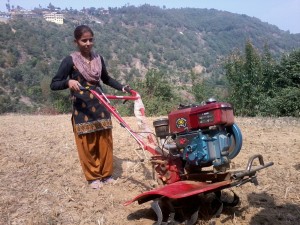Breaking Ground – Women Farmers in the Hills of Nepal Benefit from Scale-Appropriate Mechanization
Laxmi Khadka is a progressive farmer based in Nepal’s Dadeldhura district. She lives with her husband, two sons and daughter. Their farm is a mixed crop – livestock enterprise where they cultivate upland rice, wheat, maize and vegetables. In the mid-hills of Nepal, seasonal and semi-permanent male outmigration occurs at one of the highest rates in the world, which creates labor bottlenecks that erode profitability and compromise the timing of key agricultural operations.
 At present, Laxmi spends most of her time tending to her agricultural fields and livestock and struggles to balance her farm work with the needs of her family. Across the mid-hills, the burden of farm management is falling increasingly on women household members like Laxmi who stay behind. Further, the number of bullocks has declined precipitously, which also delays key farm operations like ploughing. For both reasons, the niche for scale-appropriate mechanization is strong but beyond the reach and current experience of most farmers.
At present, Laxmi spends most of her time tending to her agricultural fields and livestock and struggles to balance her farm work with the needs of her family. Across the mid-hills, the burden of farm management is falling increasingly on women household members like Laxmi who stay behind. Further, the number of bullocks has declined precipitously, which also delays key farm operations like ploughing. For both reasons, the niche for scale-appropriate mechanization is strong but beyond the reach and current experience of most farmers.
In Laxmi’s community, CSISA introduced the mini tiller as a low-cost option for rural traction and identified a group-based service provision model to recoup costs and share the technology across the village. Although initially apprehensive, community members quickly realized that the mini tiller saves time and money and Laxmi observed she was able to plant her maize with the onset of spring rains as she didn’t need to wait to hire labor or bullocks.
“From now on, we will not have to depend on the men for ploughing,” said Laxmi.
Farmers observed that it can be difficult to carry the mini tiller from one terrace to another, especially when terraces are at different heights and separated by bunds. These small problems have been solved through the collective action of the group with 2–3 farmers coordinating planting and machinery transportation from field-to-field. Farmers have also learned that operation of the mini tiller is relatively easy with most women trained in the technology by CSISA expressing and demonstrating confidence in its operation.
With timely planting assured with the mini tiller, Laxmi was also eager to evaluate additional productivity-enhancing technologies and planted maize hybrids for the first time in 2014. Her productivity levels tripled from 2013 and she produced a marketable surplus (30% of production) that was an important source of income for her family.
Tags: CSISA Nepal, Mini Tiller, Women Farmers
